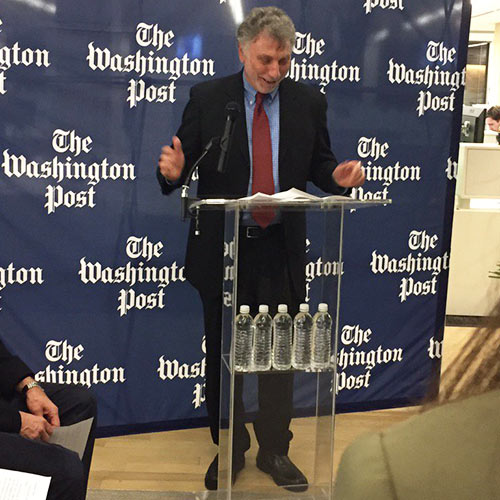Sign up for the daily CJR newsletter.
At the grand opening of The Washington Post’s glittering new K Street headquarters Thursday morning, a barista steamed milk while a jazz band played. Visitors were offered a choice of three high-end brands of bottled water, and the breakfast spread of bagels, pastries, and fruit skewers sat alongside monogrammed Washington Post napkins.
The dedication of the new Washington Post headquarters took place in the paper’s sleek public event space, The Washington Post Live Center, which looks suspiciously like The New York Times’ TimesCenter. It drew boldface names, lots of power suits, and just lots of power. Secretary of State John Kerry was there, along with the governors of Virginia and Maryland. Former Senator Chris Dodd, now CEO of the Motion Picture Association of America mingled with BET CEO Debra Lee; Ernest J. Wilson, III, dean of USC’s Annenberg School for Communication & Journalism; and Pulitzer Prize administrator Mike Pride.
John Kerry at #newposthq pic.twitter.com/y8dM1fw3iR
— Nikki Usher Layser (@nikkiusher) January 28, 2016
Few newspaper ribbon cuttings would draw such an array of glitterati, but then, few newspapers are opening grand new headquarters these days. The four-day hoopla surrounding the paper’s move from its storied 15th street headquarters to K Street, a DC power corridor lined with lobbying shops and white-shoe law firms, reinforces the stark divide between the haves and the have nots in today’s newspaper industry.
Under its new owner, Jeff Bezos, the Post is claiming digital advances while also positioning itself to become what a promotional video called “the new publication of record.” Bezos boasted on Thursday that his paper has the “best technology team… not just in the news business. I would put this team up against any team in Silicon Valley.”
The Post newsroom has gone from four engineers five years ago to dozens today. They work side by side with journalists, help the website load stories faster, and build the site’s capacity for interactivity, Executive Editor Marty Baron said. The paper can brag of record traffic, beating what Baron referred to as “all longtime competitors,” without naming The New York Times.
But the lavish celebrations felt a bit off key given that newspaper advertising revenue fell by $42 billion between 2000 and 2013. On Wednesday night, the Post dedicated the new “Ben Bradlee Story Conference Room” (also the main editorial meeting room) with lobster canapés, mini Beef Wellingtons, and fried smoked mozzarella. Guests including ABC’s Martha Raddatz, host of the Feb. 6 GOP debate, and Michael Kinsley, former editor of Slate and The New Republic, sipped Champagne, scotch, and white wine, all served in the appropriate glasses.
Journalism history and asked him about the lobster being served – Ben would have loved it @CJR pic.twitter.com/yZhA8oOiby
— Nikki Usher Layser (@nikkiusher) January 27, 2016
I asked Bob Woodward whether the lobster seemed like overkill. “We have a new owner with a lot of money, and what’s important is commitment to serious investigative reporting,” Woodward told me. “He resolves to dig.” He absolved Bezos of the costs of the canapés, instead noting: “The lobster is just a gesture to Ben and the good life he lived.” Journalists at the dozens of newspapers that have moved out of historic buildings into smaller and meaner quarters might feel differently.
Of course, the Post also has something more serious to celebrate: Jason Rezaian’s release. He spoke for the first time publicly, recalling that his captors told him “The Washington Post did not exist.” Kerry and others used the occasion to celebrate his return, and to speak glowingly about the importance of newspapers in a democracy. It was an echo of 1972, when the Post opened its 15th Street building a year after the publication of the Pentagon Papers and in the midst of Watergate. At that event, then-Secretary of State William P. Rodgers was the honored guest.
These grand openings may be primarily a bold declaration of ego and aspiration. News building design, as scholar Aurora Wallace has chronicled, speaks to the ambitions of a newspaper. Historically, the architecture of newspaper headquarters has been a sign of the power of press barons to control the fortunes of politicians and cities.
The Post’s new building evokes a digital future. There’s a giant newsroom hub, with big screens around a central configuration of cubicles—the latest fad in trying to facilitate communication and digital-first principles through design.
The building also echoes that of its rival “paper of record” to the north. There are small conference rooms with glass walls and small round tables. There is an open staircase that looks down from one floor of the newsroom to the other. The metal lettering on the front of the Post is almost identical to the metal used for The New York Times signage.
Copying the @nytimes building with small conference rooms @CJR @washingtonpost but maybe nicer? Glass enclosed pic.twitter.com/jtaEveTvTf
— Nikki Usher Layser (@nikkiusher) January 27, 2016
The Post is not your typical metropolitan newspaper, of course, nor has it ever claimed to be. It’s a national newspaper, and Bezos wants it to become even more globally influential. On Thursday, he spoke admiringly of his paper as “a little more swashbuckler, a little more swagger, and a little more badass” than others.
Time will tell if Bezos indeed is spending his money wisely, not on office buildings and lobsters, or even tech teams, but on what will indeed make this paper that already has such a huge status even bigger. For the journalists who aren’t in New York City or Washington, meanwhile, it gets harder and harder to compete.
Has America ever needed a media defender more than now? Help us by joining CJR today.







